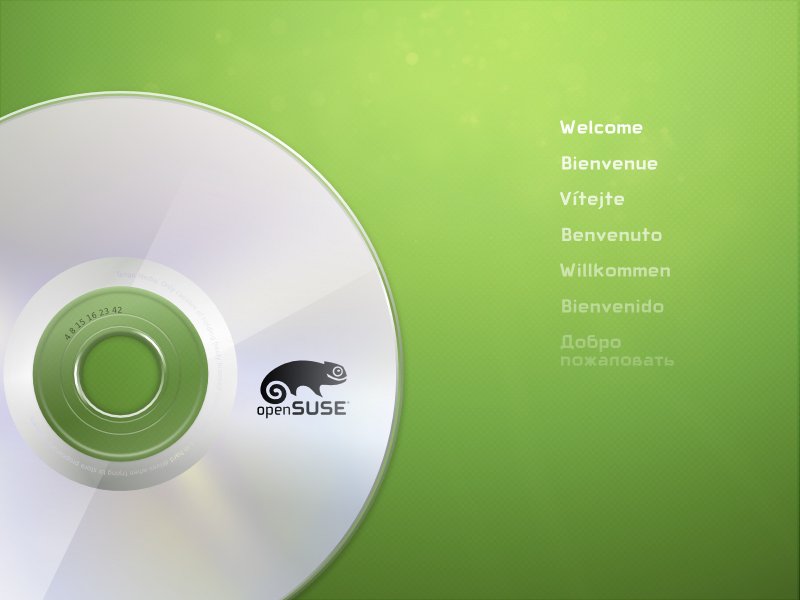openSUSE 12.2: Green Means Go!
5. Sep 2012 | Jos Poortvliet | No License
 Dear users, developers, and Geekos around the world - openSUSE 12.2 is ready for you! Two months of extra stabilization work have resulted into a stellar release, chock-full of goodies, yet stable as you all like it.
Dear users, developers, and Geekos around the world - openSUSE 12.2 is ready for you! Two months of extra stabilization work have resulted into a stellar release, chock-full of goodies, yet stable as you all like it.
(In other languages: cs de es fr it nl pt ru tr zh zh-tw)
The latest release of the w_orld’s most powerful and flexible Linux Distribution_ brings you speed-ups across the board with a faster storage layer in Linux 3.4 and accelerated functions in glibc and Qt, giving a more fluid and responsive desktop. The infrastructure below openSUSE has evolved, bringing in mature new technologies like GRUB2 and Plymouth and the first steps in the direction of a revised and simplified UNIX file system hierarchy. Users will also notice the added polish to existing features bringing an improved user experience all over. The novel Btrfs file system comes with improved error handling and recovery tools, GNOME 3.4, developing rapidly, brings smooth scrolling to all applications and features a reworked System Settings and Contacts manager while XFCE has an enhanced application finder.
“We are proud of this release, maintaining the usual high openSUSE quality standards.” said Andrew Wafaa from the openSUSE Board. “The delay in the schedule caused by our growth in the last two years means we have to work on scaling our processes. Now this release is out and with the upcoming openSUSE conference in October in Prague, the community has time and opportunity to work on that.”
A few of the most notable changes are in the following areas:

Performance
From the kernel to the desktop, openSUSE 12.2 brings you speed-ups: Linux 3.4 has a faster storage layer to prevent blocking during large transfers. glibc 2.15, the basic library, improves the performance of many functions especially on 64 bit systems. Systemd 44 enables faster booting. And KDE 4.8.4 builds on Qt 4.8.1 to make the desktop more responsive.
![]()
Evolution
openSUSE adopts the latest developments in Linux distribution technology as they mature. The GRUB2 bootloader is now the default, we’ve begun the process of revising and simplifying the UNIX filesystem hierarchy to improve compatibility across distributions, and during startup and and shutdown Plymouth 0.8.6.1 provides flicker-free transitions and attractive animations.
![]()
Polish
GNOME 3.4 introduces smooth scrolling in all applications, a reworked System Settings app and polished Contacts manager. XFCE 4.10 has an improved application finder and allows vertical panels. The Dolphin file manager is both prettier and faster.
![]()
Innovation
XOrg 1.12 introduces support for multitouch input devices, and multi-seat deployments. Mozilla Firefox supports the latest Web technologies. The llvmpipe software 3D renderer enables Gnome Shell and virtual machines to use compositing even where no 3D hardware is present. GIMP 2.8 and Krita 2.4 make Free image processing and natural media painting competitive with proprietary tools. Tomahawk Player promises to make listening to music on your computer a social experience.
![]()
Stability
LibreOffice 3.5 continues to refine the Free office suite experience with many additions and improvements. KDE 4.8.4’s email and calendaring applications have increased stability, while the next-generation btrfs filesystem now has improved error handling and recovery tools.
![]()
Management
The 3.4 kernel allows the capping of CPU usage across entire groups of processes. The new version of systemd offers a watchdog function for supervising services under its control, as well as a new process management tool. Sysadmins will benefit from a new suite of Digital Forensics/Incident Response tools.
![]()
Novelty
A set of heavyweight scientific tools brings math applications such as numeric computation, plotting, and visualization to openSUSE. The Stellarium astronomical simulator lets you explore the night sky without a telescope. Programmers will enjoy version 1.0.2 of Google’s Go language, as well as the latest C++ language standards implemented in GCC 4.7.1 and Qt Creator 2.5.
Aside from these technical changes, the documentation team has made a major revision of the reference manuals, and has introduced changes to make it easier for community contributors to write openSUSE documentation.
For more details about the latest innovations in openSUSE 12.2 visit opensuse.org/12.2.
Support and release process
As usual, this release will continue to be supported for at least 2 release cycles + 2 months. Currently, openSUSE 12.3 is scheduled in about six months, as the 12.2 release was delayed for two months. As the project is currently re-thinking its engineering- and release processes, this schedule is likely to change.
A number of changes has already been implemented to the openSUSE development process, with the release team experimenting with staging projects to distribute the integration workload and the Open Build Service team having upgraded the build farm with SSDs and using preinstall images to rapidly setup build virtual machines. More changes, however, are to be decided upon at the openSUSE Summit in Orlando and the openSUSE Conference in October in Prague. Be there if you want to make a difference!
Go, get it!
Downloads of openSUSE 12.2 can be found at software.opensuse.org/122
Users currently running openSUSE 12.1 can upgrade to openSUSE 12.2 via the instructions at this link. Users who have a properly set-up Tumbleweed setup will automatically migrate to the new release without any additional effort!
Have a lot of fun!
Categories: Announcements Distribution
Tags: